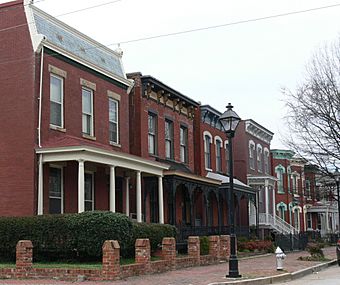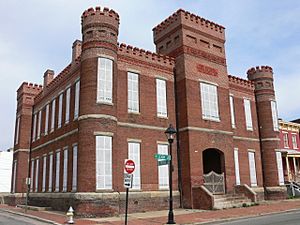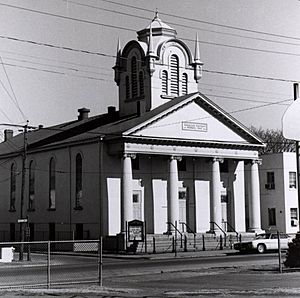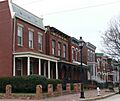Jackson Ward facts for kids
|
Jackson Ward Historic District
|
|
 |
|
| Location | Richmond, Virginia |
|---|---|
| Architect | Multiple |
| Architectural style | Greek Revival, Italianate, Late Victorian |
| NRHP reference No. | 76002187 |
Quick facts for kids Significant dates |
|
| Added to NRHP | July 30, 1976 |
| Designated NHLD | June 2, 1978 |
Jackson Ward is a special neighborhood in Richmond, Virginia. It is known for its rich African-American history. This area has a long tradition of successful African-American businesses.
Jackson Ward is close to the Virginia State Capitol. It was named a National Historic Landmark District in 1978. The name "Jackson Ward" came from its political district, or "ward," from 1871 to 1905. Even though the political meaning changed, the name stuck.
Contents
History of Jackson Ward
A Hub for Black Commerce and Entertainment
After the American Civil War, many formerly enslaved people and free African Americans came together. They built a strong business community in Jackson Ward. This area became so successful that it was called the "Black Wall Street of America."
Important leaders helped this community grow. One was John Mitchell, Jr., who was the editor of the Richmond Planet newspaper. Another was Maggie L. Walker. She was the first woman in America to start and lead a bank. This was an amazing achievement, especially since she was African-American and had a disability.
Today, you can visit the Maggie L. Walker National Historic Site. It is her former home in Jackson Ward. The National Park Service runs this museum. It became a National Historic Site in 1978 and opened as a museum in 1985.
Jackson Ward was also a major center for entertainment. People called it the "Harlem of the South." Famous musicians and performers played on "The Deuce" (2nd Street). The Hippodrome Theater hosted stars like Duke Ellington, Ella Fitzgerald, and Bill "Bojangles" Robinson. Other legends like Lena Horne, Cab Calloway, Billie Holiday, Nat King Cole, and James Brown also performed there.
Today, a statue of Bill "Bojangles" Robinson dancing stands in the neighborhood. It is at the intersection of Chamberlayne Parkway and West Leigh Street.
Changes and Challenges in Jackson Ward
Jackson Ward played a key role in the Civil Rights Movement in Richmond. In the 1940s, the city began plans to rebuild parts of Richmond. These plans, called "urban renewal," greatly changed Jackson Ward. They aimed to build new roads and buildings. However, they also caused many people to lose their homes. This broke up the community's social structure.
Many older houses were torn down to make way for new projects. These included freeways, office buildings, and the Richmond Coliseum. New public housing was built, but it often separated people by race. Many families who lived in the old homes did not get to move into the new ones.
During the 1950s, Richmond destroyed thousands of homes in black neighborhoods. They replaced them with fewer public housing units. Many people found the new housing difficult. Some historic black churches also moved out of Jackson Ward. They followed their members to other parts of Richmond.
A major highway, now part of I-95, was built through Jackson Ward. This highway destroyed many homes. It also cut the neighborhood in half. However, the community worked together to save the Sixth Mount Zion Baptist Church. This historic church was founded in 1867. Its members fought to keep it from being torn down. The highway was rerouted slightly, and the church remained.
After desegregation, African Americans could live and work in more areas of Richmond. This meant Jackson Ward's role as the main center for black businesses and entertainment slowly changed. Many older buildings in the neighborhood also started to wear down.
Jackson Ward's Revival
Towards the end of the 1900s, efforts began to bring Jackson Ward back to life. The National Park Service helped restore the Maggie L. Walker house. The neighborhood was also listed on the National Register of Historic Places in 1976. In the 1980s, special tax credits helped restore many houses.
City leaders hoped new construction would help the neighborhood. The Greater Richmond Convention Center was built nearby. However, this project also meant tearing down some historic homes.
Today, many people are buying and renovating houses in Jackson Ward. They want to live in a historic area and bring back the neighborhood's unique culture. On the first Friday of each month, the First Fridays Artwalk takes place. Art galleries open their doors, and there is live music and local food.
Jackson Ward's reputation has changed a lot. It is now a popular historic district. It is known for its vibrant community and rich history.
Architecture and Landmarks
The first houses in Jackson Ward were small cottages. They were built in the Federal style. Later, from the 1830s until the Civil War, the Greek Revival style became popular. After the 1850s, the Italianate style also appeared. These different styles give the neighborhood its unique look.
In the past, Jackson Ward was home to many different groups of people. These included German, Jewish, English, and African American residents. St. Mary's German Catholic Church was built to serve the German immigrant community.
The former Armstrong High School is in the center of the neighborhood. It is now the Richmond Public Schools Adult Career Development Center. Its sports field is now Abner Clay Park. This park has a bandstand, a football field, and courts for basketball and tennis.
Important historic churches in Jackson Ward include the Third Street Bethel African Methodist Episcopal Church, Hood Temple African Methodist Episcopal Church, Ebenezer Baptist Church, and Sixth Mount Zion Baptist Church. Sixth Mount Zion is famous for its pastor, John Jasper. His sermon, "Sun Do Move," brought him great fame.
The Leigh Street Armory is being restored. It will be the new home of the Black History Museum and Cultural Center of Virginia.
Images for kids






